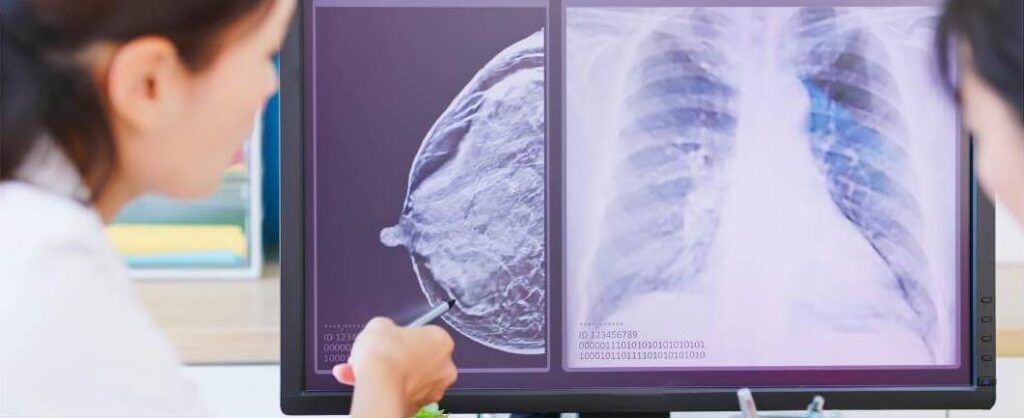Breast cancer is one of the most commonly diagnosed cancers in the world, and women are at much higher risk of developing breast cancer than men. The World Health Organization (WHO) estimates that more than 2 million new cases of breast cancer are diagnosed each year, and this number continues to rise. But why is breast cancer so common, and what are the main factors contributing to this high rate?

1. Hormone levels
One of the main factors linked to the development of breast cancer is hormone levels. Estrogen and progesterone are two of the main female hormones that regulate the menstrual cycle and pregnancy. These hormones can affect breast cells, and long-term exposure to hormones can increase the risk of developing cancer. This is especially true for women who:
- Starting menstruation at a very early age (before 12 years),
- Starting menopause at a later age (after 55 years),
- Pregnancy at a later age or living without children,
- Not using hormonal contraception or replacement therapy that contains estrogen.
Researches show that prolonged exposure to the hormone estrogen can stimulate the growth of breast cells, which increases the risk of cancer. Women who have children earlier and breastfeed more often have a lower risk of developing breast cancer because pregnancy and lactation reduce this prolonged exposure to estrogen on breast cells.
2. Do women without children have a higher risk of breast cancer?
Women who have never given birth or whose children have not been breastfed may indeed be at higher risk of breast cancer. This is due to the long-term exposure of estrogen to breast cells. Pregnancy and lactation significantly reduce the exposure of this hormone. During pregnancy, breast cells undergo structural changes that make them less susceptible to cancer. Lactation, in turn, reduces the exposure of estrogen to breast cells, as the body produces other hormones during this time that reduce the risk of developing cancer.
Thus, women who have never been pregnant or whose children have not been breastfed experience longer exposure to estrogen, which may increase the risk of developing cancer. In addition, women who postpone pregnancy until later in life or choose to live a childless life are exposed to menstruation for a longer period, which also increases the exposure of these hormones to breast cells, contributing to the possible development of cancer.
3. Genetic factors
About 5-10% of breast cancer cases are genetic. This means that some women are born with genetic mutations that increase their risk of developing breast cancer. The two most common mutations are BRCA1 and BRCA2. These mutations significantly increase the risk of developing cancer in both the breast and ovaries. Women with these genetic mutations have up to an 80% chance of developing breast cancer in their lifetime.
Family history is important. If a close relative (grandmother, mother, sister) has had breast cancer, then other family members are at increased risk of developing it as well.
4. Age and Lifestyle
Age is one of the most important risk factors for breast cancer. Most women diagnosed with breast cancer are over 50 years old, which shows that the risk of developing breast cancer increases with age. Women aged 60+ are more likely to develop the disease than younger women.
Lifestyle can also affect the risk of breast cancer. For example:
- Alcohol consumption: Studies show that alcohol consumption, even in small amounts, can increase the risk of breast cancer because alcohol can increase estrogen levels, which promote the growth of cancer cells.
- Physical activity: In contrast, regular physical activity can reduce the risk of cancer because women who are physically active have lower estrogen and insulin levels, which reduce the growth of cancer.
5. Environmental factors and chemicals
Environmental factors and chemicals related to industrial development have also been linked to an increased risk of breast cancer. Substances such as pesticides, hormones, and chemicals found in plastics (BPA) can affect the hormonal balance in the body and promote changes in breast cells.
Studies have shown that prolonged exposure to certain chemical compounds can cause cell mutations, which in turn can contribute to the development of cancer.
6. Effects of previous illnesses and treatments
Women who have had uterine cancer, especially if they have received hormone therapy, are at higher risk of developing breast cancer because the estrogen used in the therapy can promote the growth of cancer cells. Similarly, women who have had radiation therapy to the breast or breast area are at increased risk of developing breast cancer later in life because radiation can damage healthy cells, causing cell mutations. Chemotherapy can also cause side effects that affect breast tissue, for example, the drugs used during chemotherapy can damage cells and lead to the development of secondary cancers. Therefore, it is important for women who have received this type of treatment to have regular check-ups and monitor their health.
Breast cancer is a multifactorial disease that combines genetic, hormonal, environmental and lifestyle factors. Although we cannot completely prevent this disease, knowing the risk factors can help women make informed decisions about their health. Regular check-ups, a healthy lifestyle, and appropriate treatment can significantly improve the chances of detecting cancer early and successfully fighting it.
📞 For more information and registration for a consultation: +371 27 337 768
